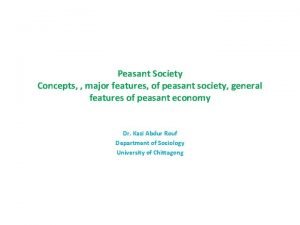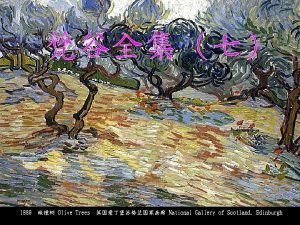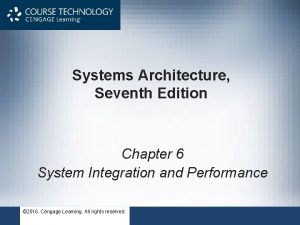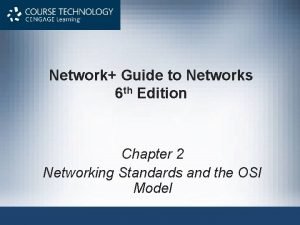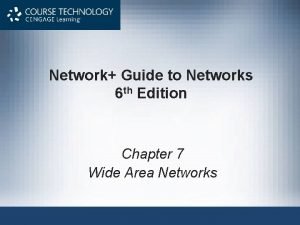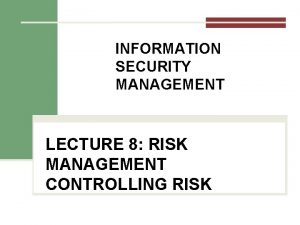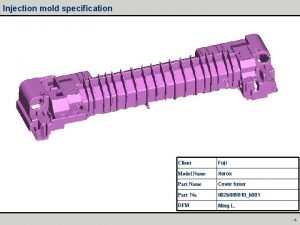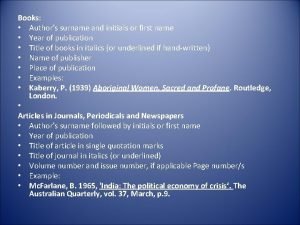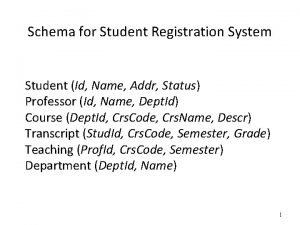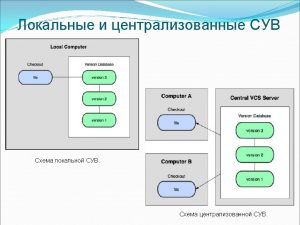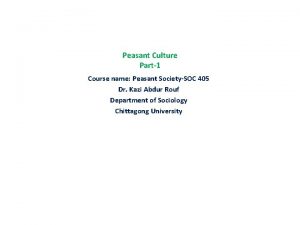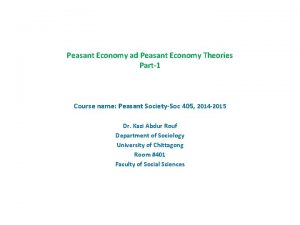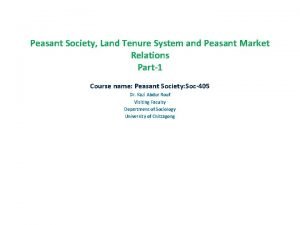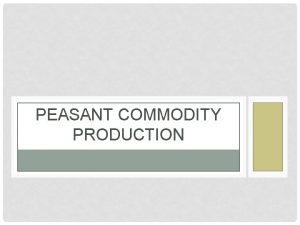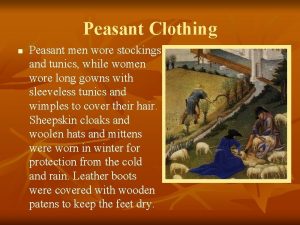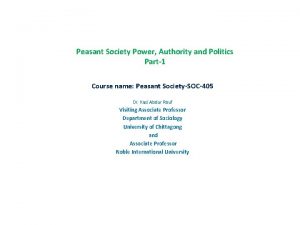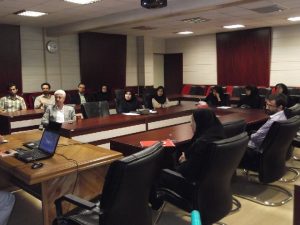Peasant Technology part 1 Course name Peasant SocietySOC405














































- Slides: 46

Peasant Technology –part 1 Course name: Peasant Society-SOC-405 Dr. Kazi Abdur Rouf Department of Sociology University of Chittagong

Agriculture Technology Use in Bangladesh Topics to be covered • • Meaning of Technology Categories Why people use Technology Transfer Types of Technology Advantages of Technology Disadvantages of Technology change in Bangladesh Context

Agriculture Technology Use in Bangladesh • • • Topics to be covered contine-2 Marxist View and Peasant Society Production System Change Western Economists View of Technological Change HYV Crops Innovations and Green Revolution Reasons for Expanding Green Revolution and Agencies Contribution to Agriculture Technology Consequences of Green Revolution Sustainable Agriculture

Agriculture Technology Use in Bangladesh Topics to be covered continue-3 • • • HYV Rice and HYV Wheat Production Statistics Land Use in Irrigation Agricultural Products in the Markets Agricultural Loans Services Cropping Intensity Wage Labor Increased in the Villages Class divisions in the Village Balance Ecology Agricultural Technology Use of Animal Power and Mechanical Power in Cultivation

Meaning of Technology • Technology is a body of knowledge devoted to creating tools, processing actions and extracting of materials • The term technology is wide and everyone has their own ways of understanding the meaning of technology • We use technology to accomplish various tasks in our daily lives, in brief; we can describe technology as products, process or organizations • We use technology to extend our abilities, and that makes people as the most important part of an technological system. • Technology is an application of science to solve a problem • Technology is the application of scientific knowledge for practical purposes, especially in industry.

Meaning of Technology continue-2 • It is about machinery and devices developed from scientific knowledge • i. e. it is the branch of knowledge dealing with engineering or applied sciences • It is the branch of knowledge that deals with the creation and use of technical means and their interrelation with life, society, and • The environment, drawing upon such subjects as industrial arts, engineering, applied science, and pure science and the application of this knowledge for practical ends. • Technology is the collection of tools, including machinery, modifications, arrangements and procedures used by humans

Meaning of Technology continue-3 • Technology has affected society and its surroundings in a number of ways • In many societies, technology has helped develop more advanced economies (including today's global economy) and has allowed the rise of a leisure class • Many technological processes produce unwanted by-products, known as pollution and deplete natural resources, to the detriment of Earth's environment • Various implementations of technology influence the values of a society and new technology often raises new ethical questions. • It is the purposeful application of information in the design, production and • Utilization of goods and services, and in the organization of human activities.

Why People use Technology • We use technology at work, we use it to , extract materials • We use technology for communication, transportation, learning, and manufacturing • Scaling business and so much more • Technology is human knowledge which involves tools, materials and systems • The application of technology results in artifacts or products • If technology is well applied, it can benefit humans • However, if it is wrongly applied, it can cause harm to human beings.

Technology is Generally divided into Five Categories • • • Communication Technology Construction Technology Assistive Technology Medical Technology Information Technology Entertainment Technology Business Technology Educational Technology Peasant cultivation Technology

Technology Transfer • It is the movement of new technology from its creator or researcher to a user • Especially as products or publications; • It is process by which existing knowledge, facilities or capabilities are utilized and • Marketed to fulfill public and private needs. • Transfer technology from technology developer/sellers to technology users • Identify peasants characters and their level of understanding and interest and ability to use technology • Develop effective processes of technology transfer to ensure that useful products reach consumers • Sort out Technology application activities

Technology Transfer continue-2 • It is also the movement of new technology from developed areas to lessdeveloped areas • Transferring of information which facilitates decision making within an organization • Improve customer service, and so much more • In this information age, it is very important to manage information systems to ensure accuracy and efficiency • Management information systems (MIS) involves planning for, development, management

Technology Transfer–continue-3 • Use of information technology tools can to help peasants to get information and knowledge of HYV variety corps and • Modern cultivation machineries and cultivation techniques • People perform all tasks related to information processing and management • It needs to develop an understanding of the problem through observation • It is necessary to identify what is the problem with the technological and • What is the problem in implementing the technology especially agricultural technology implication? • Simple language communication technology is important for adopting peasant technology in Bangladesh • Because traditional peasant society peasants are not used to use agricultural machines and other modern technology.

Advantages of Technology • Increases production: Technology helps businesses automate most tasks and this process results into increased production and efficiency. • Save times • Technology accelerates innovation • It improves sharing of information • The advancement in technology has created a new economic environment which depends on information • ‘’INFORMATION AGE’’, the information age provides a different work environment and this has helped small businesses gain position in highly competitive markets.

Disadvantages of Technology in Business • It’s expensive: Technology comes at a price, not every peasant can manage to use technology. After buying and integrating technology in agriculture, it will have to pay another cost of maintaining that technology, monthly maintenance is recommended and this can be expensive. • Not Safe: Technology is not safe; it is very easy to lose exact information if it is not written. However, peasants like to know use of technology orally. • Disconnectedness: Over-dependence on technology has killed peasant relationships, labors and

Disadvantages of Technology in Business contiue-2 • Business managers communicate through email, phones, text messages and video conferences, this kill’s face-face communication. • Such communication is expensive and needs literacy. However, poor peasants are usually illiterates which lead to dissatisfaction to peasants.

Deeply understand “WHAT IS TECHNOLOGY” • • • Peasants need to deeply understand “WHAT IS TECHNOLOGY? The meaning of technology Types of agricultural technology being used today The advantages and disadvantages of technology and How peasants can use technology to solve their cultivation problems or To meet opportunities for profit in investing the technology.

Agriculture Technology Change in Bangladesh Context • Rural Bangladesh has changed in different ways • These changes happen in structural sphere, cultural sphere, and political sphere • Important change happened in agricultural technology • Cattle plough, manual don irrigation, and cow dung fertilizer use etc. are the traditional technology in peasant society • However, these traditional technologies have changed • Because of innovation and introduction of mechanical technology and chemical fertilizer and • Pesticide technological change

Agriculture Technology Change in Bangladesh Context cotinue-2 • • Many think traditional agriculture technology change Because of capitalist relations of production Many researchers view points are different They viewed there are other reasons for changing agricultural technology in Bangladesh.

Comments/Questions

Peasant Technology –part-2 Course name: Peasant Society-SOC-405 Dr. Kazi Abdur Rouf Department of Sociology University of Chittagong

Marxist View and Peasant Society Production System Change • Marxist view think change of production system is responsible for changing peasant society • Marx himself says in his book ‘Contribution to the critique of political economy’ mentions ‘productive force’ is the determinant for social change and technology change • He says, ” Productive force (a part of technology) is the elements of historical evolution • Technology change is one of the elements of social reproductive change and it is inevitable (unavoidable).

Western economists view of Technological Change • Western economists find out reasons for technological change. • Technology is considered is the source of increasing production efficiency in agriculture sector • I. e. production efficiency increased because of technology change. • The production technology is moving and changing as long as technological frontier is expanding • More than one technological and strategic innovation • Production cost decrease is depended on technology strategic selection (James Boyee, 1987). • In technology, production cost decrease is depended on technology strategic selection (James Boyee, 1987). • It is called ‘induced innovation’ where technological changes move to a specific direction.

HYV Crops Innovations and Green Revolution • High yielding variety rice innovation is a revolution in agricultural technology • It is regarded a ‘Green Revolution’. Botanists use genetics technology to invent high yielding rice • First genetic technology used for inventing high yielding variety wheat • Then this technology applied in high yielding rice innovation • Now genetically engineers are using in potatoes, tomatoes and • Other vegetables for increasing their low productivity of yield. • Mexico Wheat Research Center • International Rice Research Institute (IRRI), Philippines • HYV crops are high responsive varieties (HRV) (Lappe and Collins, 1977)

HYV Crops Innovations and Green Revolution part-2 • • • Rice production 10 -13 mun traditional variety rice in 30 decimal lands, However, HYV rice production 18 -25 mun in 30 decimal lands Bio-chemical- mechanical technology- chemical fertilizer, pesticide Tractors, Harvester etc are mechanical technology of agricultural production Many people say these high tech mechanical technologies is for rich people Because they can afford them (inputs and machines) for their agricultural cultivations.

Reasons for Expanding Green Revolution and Agencies Contribution to Agriculture Technology • Two main reasons are: supply food to increasing population, (2) to create opportunity for profit in agriculture. • Green revolution technology has huge responded for extra food production in the world • Green revolution technologies get huge popularity among peasants and in peasant society in the world • It provides more profit to technology investors and users in green revolution • Green revolution technology opens the door or supplying food to urban people • Green Revolution starts in 1960 s during former East Pakistan and continue after independence Bangladesh • Bangladesh Academy for Rural development (BARD) or Comilla Academy is important in agricultural development in Bangladesh • Cooperative ideas and values give more importance in IRDP

Reasons for Expanding Green Revolution and Agencies Contribution to Agriculture Technology part-2 • IRDP starts to work in 400 Thanas in former East Pakistan in 1970 s • After independence of Bangladesh IRDP activities have prioritized by the state. • However, Comilla model faces many obstacles to implement its services in Bangladesh because of structural limitation • Power development Board and Bangladesh agricultural Development Corporation (BADC) are two important institution who have involved in green revolution in Bangladesh • Costal embankments help to recover saline free lands and increase cultivable lands • Flood control action program and flood control action activities in Bangladesh help HYV rice production in dry season (December, January and February).

Consequences of Green Revolution • After the green revolution, gross production of main grain, rice, has increased • However, it has created a large negative impact on rural farmers and the environment • Chemical agriculture is only oriented to economic profit, ecological and social factors are totally ignored • Chemical agriculture is totally anti-natural and destructive • Consequently this agricultural technology creates many problems • Topsoil depletion and degradation, groundwater contamination, the decline of family farms • Increasing costs of production

Consequences of Green Revolution-2 • Disintegration of economic and social conditions in rural communities, health hazards increased • Because environment (soil, air and water) pollution (agricultural products become poisonous) • Moreover it has created more ecological problems • Disappearance of Local Genetic Resources • Increase in Production Cost- Chemical agriculture is mainly dependent on external inputs and production cost increase

Sustainable Agriculture • Sustainable Agriculture is a concept that emphasizes on meeting the needs of the present without compromising the ability of future generations to meet their own needs. • If natural resources such as soil, nutrients and water are used up at a rate faster than they are replenished • Then the farming systems is unsustainable • Sustainability is also dependent on maintaining a high level of biodiversity • Economic, social, health and environmental issues have to be considered for sustainable agriculture. • Sustainable production practices involve a variety of approaches • Specific strategies must take into account topography, soil characteristics, climate, pests, local availability of inputs and the individual grower's goals.

Sustainable Agriculture contiue-2 • Diversification of crops (including livestock) and cultural practices to enhance the biological and economic stability of the farm; • Compost fertilizer also use increased with the growth of technology • Management of the soil to enhance and protect soil quality • Efficient and humane use of inputs; and • Consideration of farmers' goals and lifestyle choices. • Sustainable agriculture is essential in Bangladesh • Because it has limited land resource of 8. 3 millions hectare for 165 million people • We required necessary harmonization between indigenous knowledge and technologies. • Sustainable agriculture concept would be very much helpful to overcome the situation. A sustainable, pro-people agriculture policy should be developed by the government and a strong long term social movement is required for that.

HYV Rice and HYV Wheat Production Statistics • Rental use of tractor has expanded in the villages • The following table shows there are huge increased in rice and wheat production in Bangladesh. • HYV • Rice and wheat cultivation has widespread in Bangladesh in recent years

HYV Rice and HYV Wheat Production Statistics • Rental use of tractor has expanded in the villages • The following table shows there are huge increased in rice and wheat production in Bangladesh. HYV rice and wheat cultivation has widespread in Bangladesh in recent years. Years 1973 1978 1983 1988 HYV rice production land % out of total rice land cultivated 11. 06 12. 01 24. 84 32. 30 HYV wheat production land % out of total wheat cultivated lands 17. 67 83. 30 95. 95 1000. 00 • Source: The agriculture sector in Bangladesh and data base, USAID, Bangladesh 1989, p. 68. HYV crops production out of total cultivable land 11. 14 13. 32 28. 17 36. 01

Land Use in Irrigation System 1981 1984 1987 Modern irrigation 2, 496 3, 355 8, 549 Traditional irrigation 1, 555 1, 449 890 Source: The agriculture sector I Bangladesh – a data base, USAID/Bangladesh, 1989, p. 64.

Comments/Questions

Peasant Technology part-3 Course name: Peasant Society-SOC-405 Dr. Kazi Abdur Rouf Department of Sociology University of Chittagong

Agricultural Products for the Markets Traditional paddy production is 1. 61 ton per hector Whereas HYV is 3. 87 time higher. It is more than double Market develops in the villages and establishes exchange relations Market based rural economics change has accelerated Many peasants become capitalistic peasants by regularly producing commodity • As surplus production increased, hence surplus commodity can sell markets • Irrigation machine, irrigation water, chemical fertilizer, pesticides all are capital based or capital intensive agriculture production Profit making is one of the main obstacles of the many peasants in rural Bangladesh • This is the reason for increasingly capital investment in village • • •

Agricultural Loans Services • • Here state has extended its loan service to peasants For example, in 1975 -76, the numbers of rural bank branches were 858 Which have increased to 32000 bank branches in the rural areas in 1983/84 During these periods the agriculture loan supply real value increased 8 times In 1975, agricultural loan amount was only 5 core taka Bangladesh Bank, National Cooperative Bank, IRDP and Many other commercial banks extend their loan services to peasants in Bangladesh.

Cropping Intensity • Intensive crop farming is a modern form of intensive farming that refers to the industrialized production of crops • Intensive crop farming's methods include innovation in agricultural machinery, farming methods • Genetic engineering technology, techniques for achieving economies of scale in production • Cropping intensity cultivation increased because of technology development • Moreover, it is because availability of irrigation during dry season • Agricultural cultivation opportunity spread/increased by flood control program • Increased irrigation facilities and water sewerage disposing facilities • HYV paddy can cultivate in lowland in rainy seasons

Cropping Intensity continue-2 • Moreover, access water dispose and reservation of inland water creates an opportunity for water irrigation on paddy land • BIDS survey shows that advanced technology villages have increased 165% intensive crop cultivation whereas backward villages have increased 132. 2% crop intensity cultivation • However, other crops productions squeeze in Bangladesh

Wage labor Increased in the Villages • Wage labor opportunity increased by green revolution • Scope of wage labor increased because of paddy cultivation throughout the year but • However, use of tractor not increased • Weeds are now growing more in HYV paddy field • It is the reaction of using chemical fertilizer). • Weed out job needs more labor

Class divisions in the Village • • Class differentiation (Rich and poor) has increased Peasant class division increased in the village Few rich peasants have more lands However, huge people turn to become marginalized peasants

Balance Ecology Agricultural Technology • Recently attention has put to make ecological balance in green evolution • A new ecological dimension has created in apicultural technology • It is assumed more important emphasis given to ecological balance in using and • Expanding agricultural technology elsewhere.

Use of Animal Power and Mechanical Power in Cultivation • • • 260 horse animal power use for traditional paddy production per hector land 296 horse animal power uses for HYV rice production in Bangladesh 55 horse animal power use for rice harvesting and husking 65 horse animal power uses for HYV rice harvesting and husking Mechanical power is not used for both traditional and HYV rice harvesting Two hours mechanical power uses for irrigating traditional rice production Whereas 36 hours used for irrigation for HYV rice production 19 hours mechanical power used for traditional rice variety husking and 22 hours mechanical power uses for high yielding variety rice husking.


Comments/Questions

 Name a line containing point a
Name a line containing point a Clergy and nobles
Clergy and nobles Explain the major features of peasant society
Explain the major features of peasant society Spittled mirth meaning
Spittled mirth meaning Tudor clothing poor
Tudor clothing poor Peasant woman binding sheaves
Peasant woman binding sheaves Utah ddw
Utah ddw Presumptuous in french
Presumptuous in french Peasant meal 1642
Peasant meal 1642 Sailor course brick
Sailor course brick Course number and title
Course number and title Course interne moyenne externe
Course interne moyenne externe Crash course muscles part 2
Crash course muscles part 2 Acct challenge course
Acct challenge course Course technology cengage learning
Course technology cengage learning Course technology cengage learning
Course technology cengage learning Course technology cengage learning
Course technology cengage learning Course technology cengage learning
Course technology cengage learning Part whole model subtraction
Part whole model subtraction Unit ratio definition
Unit ratio definition Part part whole
Part part whole Define technical description
Define technical description Parts of a bar graph
Parts of a bar graph The part of a shadow surrounding the darkest part
The part of a shadow surrounding the darkest part Part to part variation
Part to part variation Technology parts of speech
Technology parts of speech What is the function of seed
What is the function of seed Vulva
Vulva Parts of the boy
Parts of the boy What is the name of the first part of an outline?
What is the name of the first part of an outline? Injection part name
Injection part name Authors by initials
Authors by initials Name above every other name
Name above every other name Rectangle with all sides equal
Rectangle with all sides equal Public class person string name
Public class person string name What is his name
What is his name Name of presentation company name
Name of presentation company name Name of presentation company name
Name of presentation company name Name class teacher date
Name class teacher date What is my name
What is my name What is your name how old are you
What is your name how old are you Name class subject
Name class subject Student id name department name
Student id name department name Git user name
Git user name Lecturer's name or lecturer name
Lecturer's name or lecturer name Inception desk
Inception desk Name date class teacher
Name date class teacher


